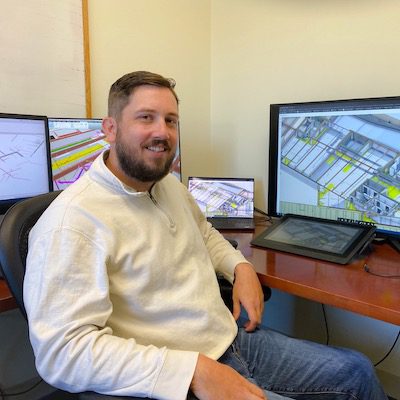
This past year has been an interesting one for the construction folks, to say the least. In 2022, we kicked off strong with four consecutive months of increased construction spending. However, supply chain bottlenecks, inflation, and labor shortages all remained significant challenges for the construction industry. A 2022 study by the Associated General Contractors of America (AGC) and Autodesk found that 93% of construction firms have unfilled positions.
Challenges will certainly flow into the coming year, but there are many reasons to be optimistic. To gain even more insights into the exciting opportunities and transformations in the year ahead, we asked more than 20 construction industry thought leaders and insiders to share their trends and predictions for 2023. This year, we've broken down their insights into three main focus areas:
Take a look at what they have to say.
 “The construction industry realizes that to drive more predictability, profitability, and safety into their processes, firms must continue to embrace digital technologies and innovation in 2023. Today, backlogs remain strong – but construction activity is a lagging indicator. With a potential recession looming, I expect construction companies to counterintuitively increase their innovation efforts to find new ways to deliver projects more cost-effectively. This innovation will be thoughtful and directed, specifically focused on solving nagging problems and challenges on the jobsite such as labor needs and material tracking. I also expect a surge of interest in using data to identify and predict issues earlier, and to provide key learnings and insights both at the project level and at the business level.
“The construction industry realizes that to drive more predictability, profitability, and safety into their processes, firms must continue to embrace digital technologies and innovation in 2023. Today, backlogs remain strong – but construction activity is a lagging indicator. With a potential recession looming, I expect construction companies to counterintuitively increase their innovation efforts to find new ways to deliver projects more cost-effectively. This innovation will be thoughtful and directed, specifically focused on solving nagging problems and challenges on the jobsite such as labor needs and material tracking. I also expect a surge of interest in using data to identify and predict issues earlier, and to provide key learnings and insights both at the project level and at the business level.
Furthermore, rising environmental and government pressure as well as requirements from responsible owners will drive the industry to make better, informed decisions regarding more sustainable materials and methods. Specifically, we’ll see a rise in the use of embodied carbon calculators, which will help project teams determine the impact of emissions generated by materials used during construction. I also expect this pressure to drive a steep increase in DfMA and other offsite and modular methods. In addition to helping better manage the environmental impact of construction, modular construction methods will improve project productivity, deliver construction outputs more quickly, better manage scarce resources, and improve site safety.” - Jim Lynch, Senior Vice President & General Manager, Autodesk Construction Solutions
 “Traditional industry business models will shift towards data truly being valued as an asset- providing new service offerings and new business models for the industry and society.” - Adam Plunkett, Group Manager- Business Technology & Planning, John Holland
“Traditional industry business models will shift towards data truly being valued as an asset- providing new service offerings and new business models for the industry and society.” - Adam Plunkett, Group Manager- Business Technology & Planning, John Holland
 “In the next decade, I see the construction industry advancing by getting smart about bringing the best technologies together in a single platform resulting in a shorter construction duration. I see the design process being streamlined and the term “Drawings are diagrammatical” being a thing of the past.” - Breawn Felix, Regional Support Services Manager, Swinerton Builders
“In the next decade, I see the construction industry advancing by getting smart about bringing the best technologies together in a single platform resulting in a shorter construction duration. I see the design process being streamlined and the term “Drawings are diagrammatical” being a thing of the past.” - Breawn Felix, Regional Support Services Manager, Swinerton Builders
 “Hybrid work and an increased focus on sustainability and reducing our carbon footprint will create more opportunities for innovation and leveraging prefabrication and modularization in ways we haven’t before. Trends like mass timber will change the way we design, construct, and operate buildings. Construction tech will continue to rapidly disrupt the industry with focus on the connected jobsite and leveraging data collection and interconnectivity to increase productivity, quality, and safety. Additionally, we will continue to see more and more opportunities to automate workflows by leveraging low/no code solutions, AI, and robotics.” - Danielle O’Connell, Sr. Director, Emerging Technology, Skanska USA Building Inc.
“Hybrid work and an increased focus on sustainability and reducing our carbon footprint will create more opportunities for innovation and leveraging prefabrication and modularization in ways we haven’t before. Trends like mass timber will change the way we design, construct, and operate buildings. Construction tech will continue to rapidly disrupt the industry with focus on the connected jobsite and leveraging data collection and interconnectivity to increase productivity, quality, and safety. Additionally, we will continue to see more and more opportunities to automate workflows by leveraging low/no code solutions, AI, and robotics.” - Danielle O’Connell, Sr. Director, Emerging Technology, Skanska USA Building Inc.
"Construction tech will continue to rapidly disrupt the industry with focus on the connected jobsite and leveraging data collection and interconnectivity to increase productivity, quality, and safety."
 “With climate change and irreversible damages to the environment, we need to ask ourselves if we can go on like this.
“With climate change and irreversible damages to the environment, we need to ask ourselves if we can go on like this.
We have to reduce our resource consumption and our CO2 emissions. This is not easy because our current business models are centered on growth. With technology, we can adapt the ways things are being designed, built, and operated. But the rules of the game need to change more deeply. To lower the pressure put on the planet, we also need to transform the business models governing companies, project delivery networks, supply chains, ecosystems and the whole industry. This is urgent.” - Olivier Lépinoy, Global Business Development, Autodesk
 “In the last few years, we as a business have seen more of an emphasis on quality. Prior to this, the industry was primarily focused on getting the job done as fast and as cheaply as possible. But now what we've started to see is a huge mindset shift towards quality. Owners are willing to pay more for a better-quality asset because they ultimately understand the value they get over the course of the lifecycle of that asset. If we can build it right, the first time not only will see an exponential rise in productivity and quality, but we’ll also save time, money and radically reduce waste onsite.
“In the last few years, we as a business have seen more of an emphasis on quality. Prior to this, the industry was primarily focused on getting the job done as fast and as cheaply as possible. But now what we've started to see is a huge mindset shift towards quality. Owners are willing to pay more for a better-quality asset because they ultimately understand the value they get over the course of the lifecycle of that asset. If we can build it right, the first time not only will see an exponential rise in productivity and quality, but we’ll also save time, money and radically reduce waste onsite.
Across 2023 I think we’ll see owners put more investment upfront into what will get them a better quality project delivery. Meanwhile, the contract game is beginning to change as well. Owners are becoming much more willing to sit down with contractors when issues occur to figure out solutions into what’s working and what’s not.” - Waleed Zafar, Mission Critical Director, XYZ Reality
 “I recently headed the Costco Santa Fe, Mexico project. It is a multilevel Costco warehouse in the heart of a big city, but it is hidden under a massive green roof and a sports facility that includes a soccer field and two basketball courts. I see an increase in multilevel warehouses in urban environments, that connect to the community and become part of the neighborhood. The design, engineering, and construction were unique, complex, and challenging. And I expect and look forward to many more of these exciting efforts in the next decade.” - Maribel F. Barba, Associate, MG2
“I recently headed the Costco Santa Fe, Mexico project. It is a multilevel Costco warehouse in the heart of a big city, but it is hidden under a massive green roof and a sports facility that includes a soccer field and two basketball courts. I see an increase in multilevel warehouses in urban environments, that connect to the community and become part of the neighborhood. The design, engineering, and construction were unique, complex, and challenging. And I expect and look forward to many more of these exciting efforts in the next decade.” - Maribel F. Barba, Associate, MG2
 "Increasing tech investment - Tech investment in construction is going to be really huge over the next decade. This will help improve the production of teams in different ways given the use of robotics, AI, and machine learning in this field. This will help with remote visual project progress tracking.
"Increasing tech investment - Tech investment in construction is going to be really huge over the next decade. This will help improve the production of teams in different ways given the use of robotics, AI, and machine learning in this field. This will help with remote visual project progress tracking.
Stress on data collection, research, and management - With the advance of the types of construction software, the methodologies of collecting and using data, with regards to preconstruction and operations is helping the way we bid projects and forecast production on projects. This will be very instrumental in budgeting future projects given certain relevant parameters.
Improved supply chain research - Focus on robust procurement methods and supply chain research will be one of the mainstream efforts based on all the post covid issues faced by the industry. This will definitely be another market worth exploring in construction tech over the next decade." - Suchayita (Sue) Bhattacharjee, Director of Preconstruction, Herrero Builders
 “In my opinion, technology is the key to everything. A lot of companies over the past couple decades have been slow to adopt new technology and or systems. I think the next decade will be a transformation in acceptance and use of technology.” - Landon Arciero, Senior Project Manager, Largo Concrete Inc
“In my opinion, technology is the key to everything. A lot of companies over the past couple decades have been slow to adopt new technology and or systems. I think the next decade will be a transformation in acceptance and use of technology.” - Landon Arciero, Senior Project Manager, Largo Concrete Inc
 “Access to a skilled workforce will continue to challenge the construction industry in 2023. Seasoned professionals are retiring and leaving institutional knowledge gaps within firms. In parallel, the industry is not replacing one-to-one for those leaving, creating a delta for the next generation of construction leaders going forward.
“Access to a skilled workforce will continue to challenge the construction industry in 2023. Seasoned professionals are retiring and leaving institutional knowledge gaps within firms. In parallel, the industry is not replacing one-to-one for those leaving, creating a delta for the next generation of construction leaders going forward.
Knowing that the industry cannot attract and retain a workforce fast enough, we have to increase efficiency and effectiveness with advanced digital construction management methods and tools. Digital upskilling and training for specific technology, as well as a broader focus on knowledge sharing, is critical to capture institutional knowledge and IP that is leaving the business due to retirement. We’ll also continue to see more construction firms reduce silos for digital methodologies and pull that skillset and methods across the organization. The knowledge will no longer live within the BIM/VDC or innovation departments – it will be more broadly part of the means and methods of preconstruction and operations. This shift creates compelling opportunities for digital natives to flex their experience to help firms adopt more sophisticated workflows, enabling them to attract and retain emerging leaders due to an increase in career paths that are tech-enabled.
As construction firms look for additional ways to attract and retain new talent, many have also realized the importance of robust training and knowledge sharing programs to nurture a culture of learning and development. According to a recent survey by Deloitte, firms that have high learning cultures have 30–50% higher employee engagement and retention rates. As a result, we’ll also see an increase in user and behavior-based training across the industry. Recognition and gamification of learning to incentivize ongoing development is poised to grow as firms look to entice talent to upskill, stay within the organization, and increase effectiveness.” - Allison Scott, Director, Customer Experience & Industry Advocacy, Autodesk Construction Solutions
"Digital upskilling and training for specific technology, as well as a broader focus on knowledge sharing, is critical to capture institutional knowledge and IP that is leaving the business due to retirement."
 “AR is evolving so quickly across the industry and everyone is trying to keep up with what's the latest and greatest. We constantly see new and incredible vendors pushing the limits of the technology today. At United Association, we're even creating a curriculum with AR and VR because we know that excites workers. If we can put people in the VR world in a gaming mode, it’s a win for training and keeps workers engaged. I see a lot of potential for this in the future. So much is changing in the industry and the workforce, and we need to adapt to a new way.” - Ken Schneider, Training Specialist, UA Education and Training Department
“AR is evolving so quickly across the industry and everyone is trying to keep up with what's the latest and greatest. We constantly see new and incredible vendors pushing the limits of the technology today. At United Association, we're even creating a curriculum with AR and VR because we know that excites workers. If we can put people in the VR world in a gaming mode, it’s a win for training and keeps workers engaged. I see a lot of potential for this in the future. So much is changing in the industry and the workforce, and we need to adapt to a new way.” - Ken Schneider, Training Specialist, UA Education and Training Department
 “AI is poised to have a positive impact on multiple aspects of construction, including AI-powered BIM design, increased worker safety and risk mitigation, but I believe one of the most significant impacts of AI will be its use in tracking productivity. AI will be able to use visual recognition technology that can identify different trades (i.e., drywall, piping, ductwork, etc.) as well as the meta data from BIM designs, to track production based on planned durations and quantities for scope. That will enable companies to understand productivity in real-time and use those insights to better manage project schedules, costs and more. The impact of this on the bottom line of construction companies will be dramatic, and the first steps toward this new use of AI will happen in 2023. In fact, Compass is using that technology today in our Dallas-Fort Worth data centers campus, and it’s pretty cool stuff.” - Nancy Novak, Chief Innovation Officer, Compass Datacenters
“AI is poised to have a positive impact on multiple aspects of construction, including AI-powered BIM design, increased worker safety and risk mitigation, but I believe one of the most significant impacts of AI will be its use in tracking productivity. AI will be able to use visual recognition technology that can identify different trades (i.e., drywall, piping, ductwork, etc.) as well as the meta data from BIM designs, to track production based on planned durations and quantities for scope. That will enable companies to understand productivity in real-time and use those insights to better manage project schedules, costs and more. The impact of this on the bottom line of construction companies will be dramatic, and the first steps toward this new use of AI will happen in 2023. In fact, Compass is using that technology today in our Dallas-Fort Worth data centers campus, and it’s pretty cool stuff.” - Nancy Novak, Chief Innovation Officer, Compass Datacenters
 “One of the trends that excites me the most about the sheet metal trade is robotics. Robotics is really growing – just look what HP is doing with SitePrint for instance. While it still is going to take skills to be able to work, robotics is going to help our workers be more efficient especially when it comes to daily and more generic tasks.
“One of the trends that excites me the most about the sheet metal trade is robotics. Robotics is really growing – just look what HP is doing with SitePrint for instance. While it still is going to take skills to be able to work, robotics is going to help our workers be more efficient especially when it comes to daily and more generic tasks.
Robotics is definitely going to have an impact on our sheet metal and pipe fitter shops even five or ten years down the road. Eventually, that impact is going to expand to the jobsite too. For instance, look what Boston Dynamics is doing with Spot. We’re already seeing that come to life.” - Ron T. McGuire, Program Administrator, International Training Institute
 “I believe the future of the construction industry will be one driven by pre-fabrication and modular construction building methods. We also will have a workforce that will have to be multi-disciplinary in their skillset. Just like athletes and entertainers must have multiple areas of skill and talent, so must the successful tradespersons of the future. We are seeing both concepts coming to fruition currently in the Electrical Industry specifically.” - Matt Allread, Education Manager, Gaylor, Electric, Inc.
“I believe the future of the construction industry will be one driven by pre-fabrication and modular construction building methods. We also will have a workforce that will have to be multi-disciplinary in their skillset. Just like athletes and entertainers must have multiple areas of skill and talent, so must the successful tradespersons of the future. We are seeing both concepts coming to fruition currently in the Electrical Industry specifically.” - Matt Allread, Education Manager, Gaylor, Electric, Inc.
 “Effective risk management, unlocking operational efficiencies, and driving faster payment cycles will be front and center for construction companies in 2023 especially as an uncertain macroeconomic climate persists. Against this backdrop, we expect to see construction companies increasingly invest in preconstruction technologies to ensure they can future proof their projects through better scoping, planning, and coordination prior to construction commencing.
“Effective risk management, unlocking operational efficiencies, and driving faster payment cycles will be front and center for construction companies in 2023 especially as an uncertain macroeconomic climate persists. Against this backdrop, we expect to see construction companies increasingly invest in preconstruction technologies to ensure they can future proof their projects through better scoping, planning, and coordination prior to construction commencing.
At the same time, we expect to see construction companies become increasingly data driven across their business processes. Today, while contractors generate significant amounts of data across their projects, it is typically stored across multiple disparate systems making it unusable to inform business decisions. Unlocking the value of this data to derive actionable insights will be critical to the future success of construction companies. Ultimately, construction firms can reduce risk and make smarter decisions with the right insights, which requires standardized data practices (including benchmarking) and making information readily accessible to all team members. The more siloed workflows are, the more challenges firms will face in getting a comprehensive view of projects and information across their organization. Companies that standardize how teams access data and derive insights will set themselves up for long-term success, and I believe this will be a priority for many construction firms in 2023.
Finally, with labor shortages continuing to negatively impact the industry, construction companies will look to adopt more automation both on the jobsite for field execution as well as for office-based project management tasks. To that end, I expect to see firms aggressively leverage both robotics and AI/ML in order to augment the worker, save time and more importantly enable focus on higher value activities.” - Sidharth Haksar, Senior Director, Head of Construction Strategy & Industry Partnerships, Autodesk Construction Solutions
 “The most significant trend will continue to be a digital overhaul of the construction landscape. Value is going to live inside of data more than it ever has before. If you can collect, analyze and validate data, you will become one of the most valuable members of the industry for the next decade.” - Jacob D’Albora, FMP, Director of Digital Building Operations, VIATechnik, LLC
“The most significant trend will continue to be a digital overhaul of the construction landscape. Value is going to live inside of data more than it ever has before. If you can collect, analyze and validate data, you will become one of the most valuable members of the industry for the next decade.” - Jacob D’Albora, FMP, Director of Digital Building Operations, VIATechnik, LLC
 “In the coming decades, data collecting will continue to advance, as will the use of data for decision-making using machine learning and artificial intelligence (AI). Digital twins will continue to be widely used for a variety of purposes, including design and construction as well as facilities management. The digital model will also become more accessible for usage in augmented reality and mixed reality applications in the field and operations. The utilization of digital platforms will receive more attention, and UI/UX will be essential to their adoption.” - Muhammad Khalil Bin Shaiful Bahari, Deputy Director - Group Technology Office, Boustead Projects Limited
“In the coming decades, data collecting will continue to advance, as will the use of data for decision-making using machine learning and artificial intelligence (AI). Digital twins will continue to be widely used for a variety of purposes, including design and construction as well as facilities management. The digital model will also become more accessible for usage in augmented reality and mixed reality applications in the field and operations. The utilization of digital platforms will receive more attention, and UI/UX will be essential to their adoption.” - Muhammad Khalil Bin Shaiful Bahari, Deputy Director - Group Technology Office, Boustead Projects Limited
 “Automation is the way of the future. I don’t mean this as though we will have robots everywhere doing all the labor while we sit in air-conditioned trailers, I see it as the automation of data. We are in a society that has an ever-growing hunger for data, which is causing the very early stages of a bottleneck in workflows. To manage all of the data that is now being required by owners and for the construction process, a specific person or persons are being required to handle it.
“Automation is the way of the future. I don’t mean this as though we will have robots everywhere doing all the labor while we sit in air-conditioned trailers, I see it as the automation of data. We are in a society that has an ever-growing hunger for data, which is causing the very early stages of a bottleneck in workflows. To manage all of the data that is now being required by owners and for the construction process, a specific person or persons are being required to handle it.
Progress tracking of the construction process is a fantastic example. Before, it was highlighting physical drawings or just updating percentages on a white board, this eventually has progressed to highlighting a PDF or updating percentages on an Excel file. Now there are many ways to more accurately track this data with different software. These are all huge steps forward in being able to manage the vast amount of data created on large projects. There is now a new problem that this has exposed. Everyone is too busy to manage and enter all of the data. The way it stands now everything must be entered manually. If you want a 3D representation of your progress tracking you must click on every piece of duct, pipe, conduit, mechanical equipment, and change its status. This can be extremely time consuming and this is where the automation comes in. There are many companies starting to offer automated progress tracking where AI will figure out what has been installed and even installed incorrectly by comparing what it sees from a video walkthrough or photos to your coordination model. This takes the time investment from project staff from many hours a week to the time it takes to walk through the building. By having them put a camera on their hardhat and do a walkthrough of the building that they would already be doing, you can now have an accurate and up to date progress model of the building. While this is still currently very costly from a cost perspective, it will come down in price as all technology eventually does. But I think this will open the floodgates on using AI on jobsites to accurately and efficiently collect and manage data. I see in the future the speed of AI increasing to a point where we walk around a jobsite with 360 camera on our hardhats and while we walk, do inspections, or have conversations with people the AI will be checking everything it sees and give us an alert when it sees something out of place that will cause an issue in the future. I believe this is the most likely path forward with technology much more so than us regularly seeing robots in the field doing the job of an actual person.” - Andrew Cooper, VDC Engineer, AECOM Hunt
 “In the next decade there will be continuous enhancements in tools and software that aid in bringing the real-life job site into the virtual world, in essence bringing the jobsite back to the office or home office. Live progress tracking and more intimacy with site conditions from offsite locations will help to get all parties involved on the same page and identify issues early in the process as well as aid in scheduling and identifying prefabrication opportunities. Virtual reality and mixed reality will be an everyday part of construction, immersing anyone into the jobsite from any location.” - Brian Harlow, VDC Specialist, Interstate Electrical Services
“In the next decade there will be continuous enhancements in tools and software that aid in bringing the real-life job site into the virtual world, in essence bringing the jobsite back to the office or home office. Live progress tracking and more intimacy with site conditions from offsite locations will help to get all parties involved on the same page and identify issues early in the process as well as aid in scheduling and identifying prefabrication opportunities. Virtual reality and mixed reality will be an everyday part of construction, immersing anyone into the jobsite from any location.” - Brian Harlow, VDC Specialist, Interstate Electrical Services
 “Everyone should get comfortable with augmented reality now because it’s only a matter of time before mixed reality becomes a daily tool on most construction sites. Most of the technologies we deploy on-site are reactive technologies; mixed reality is a proactive technology that will change how our superintendents and foreman conduct daily site walks and inspections.” - Christian Waldo, VDC Manager, Lydig Construction
“Everyone should get comfortable with augmented reality now because it’s only a matter of time before mixed reality becomes a daily tool on most construction sites. Most of the technologies we deploy on-site are reactive technologies; mixed reality is a proactive technology that will change how our superintendents and foreman conduct daily site walks and inspections.” - Christian Waldo, VDC Manager, Lydig Construction
 “In the last decade, we have seen the shift from CAD to BIM increase rapidly to the point where multiple users are working in the same data environment, like Revit, is commonplace. The current file-based paradigm in software may have some room left to grow but it’s getting close to a peak. This trend will continue in the next decade as from the user’s perspective distinctions between files will be blurred, and the greatest value will be in platforms that deliver asset management. We can already see this in GIS systems so popular you don’t even think of them in such terms, when searching for a destination in Google Maps, you are interacting with a successful UX that is focused on presenting data rather than files. The construction industry is well overdue for a similar shift but is slow to react to each decade’s new opportunities. Construction documentation is stagnated as a legal interpretation of the employer’s requirements, doing little more than comparing episodes of existing and proposed. My hope is that the next decade will see an evolution in linked systems for graphical and scheduled data, where designing, building, operating, and maintaining assets is as intuitive and universal as social media.” - Adam Bear, Strategic Digital Manager, Wessex Water
“In the last decade, we have seen the shift from CAD to BIM increase rapidly to the point where multiple users are working in the same data environment, like Revit, is commonplace. The current file-based paradigm in software may have some room left to grow but it’s getting close to a peak. This trend will continue in the next decade as from the user’s perspective distinctions between files will be blurred, and the greatest value will be in platforms that deliver asset management. We can already see this in GIS systems so popular you don’t even think of them in such terms, when searching for a destination in Google Maps, you are interacting with a successful UX that is focused on presenting data rather than files. The construction industry is well overdue for a similar shift but is slow to react to each decade’s new opportunities. Construction documentation is stagnated as a legal interpretation of the employer’s requirements, doing little more than comparing episodes of existing and proposed. My hope is that the next decade will see an evolution in linked systems for graphical and scheduled data, where designing, building, operating, and maintaining assets is as intuitive and universal as social media.” - Adam Bear, Strategic Digital Manager, Wessex Water
"My hope is that the next decade will see an evolution in linked systems for graphical and scheduled data, where designing, building, operating, and maintaining assets is as intuitive and universal as social media."
 “I predict everything will be hosted in the cloud. All files and applications will be cloud-based. The need for heavy-duty hardware to handle large files or to keep up with complicated software will start to be obsolete. This will allow more collaboration and connection with all stakeholders by hosting a live single source of truth accessible to all via the cloud.” - Kacie Hokanson, Virtual Construction Specialist, Miron Construction Co., Inc.
“I predict everything will be hosted in the cloud. All files and applications will be cloud-based. The need for heavy-duty hardware to handle large files or to keep up with complicated software will start to be obsolete. This will allow more collaboration and connection with all stakeholders by hosting a live single source of truth accessible to all via the cloud.” - Kacie Hokanson, Virtual Construction Specialist, Miron Construction Co., Inc.
 “I predict technology will continue to grow and evolve in the construction industry like never before. From expansion of cloud based platforms to the use of robotics and drones.” - Katrina Smith, Project Manager, Pan-Pacific Mechanical
“I predict technology will continue to grow and evolve in the construction industry like never before. From expansion of cloud based platforms to the use of robotics and drones.” - Katrina Smith, Project Manager, Pan-Pacific Mechanical
 “The tools and processes of the IT industry is already getting a lot of love in the construction industry. I think it’s going to continue to evolve, things such as blockchain is sure to be used in very smart ways, and I’m sure the gaming industry will have more and more of an influence in the construction industry. As the people in the industry become more and more those that grew up with internet and smartphones, it’s surely going to change the industry towards this way of thinking.” - Kristoffer Flygare, Technology Manager, Bravida Sverige AB
“The tools and processes of the IT industry is already getting a lot of love in the construction industry. I think it’s going to continue to evolve, things such as blockchain is sure to be used in very smart ways, and I’m sure the gaming industry will have more and more of an influence in the construction industry. As the people in the industry become more and more those that grew up with internet and smartphones, it’s surely going to change the industry towards this way of thinking.” - Kristoffer Flygare, Technology Manager, Bravida Sverige AB
Which construction trends are you most excited about in 2023? Share your thoughts in our comments section, below.
Meanwhile, you can stay ahead of the latest in construction this year and beyond by subscribing to our blog. Get construction tips, tricks, insight, and news, delivered straight to your inbox!

May we collect and use your data?
Learn more about the Third Party Services we use and our Privacy Statement.May we collect and use your data to tailor your experience?
Explore the benefits of a customized experience by managing your privacy settings for this site or visit our Privacy Statement to learn more about your options.